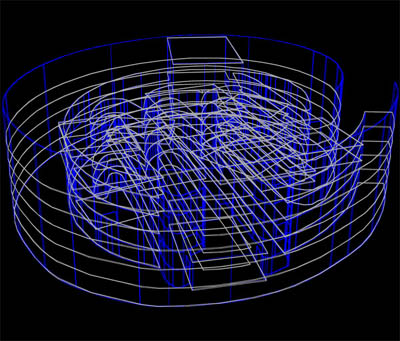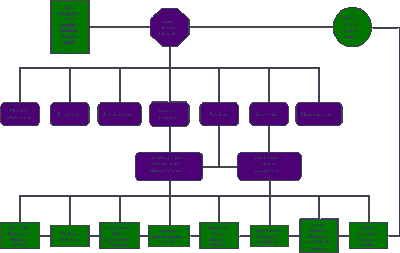![]()
![]()
![]()
![]()
![]()
![]()
![]()
![]()
![]()
![]()
![]()
![]()
![]()
Archives & Museum Informatics
158 Lee Avenue
Toronto, Ontario
M4E 2P3 Canada
info @ archimuse.com
www.archimuse.com
| |
Search A&MI |
Join
our
Mailing List.
Privacy.
published: April, 2002
Swiss National Museums - The Design of a Virtual Museum
Konrad Jaggi, Swiss National Museums, Zurich
Harald Kraemer, Transfusionen, Vienna/Berlin
Abstract
The Swiss National Museums (Musée Suisse Group, http://www.musee-suisse.ch/) consists of a network of 8 museums, located in various cantons of Switzerland. Since 1998 the Swiss National Museums have been in a phase of reorganization and modernization. Part of this process is the renovation of the first Swiss National Museum (Schweizerisches Landesmuseum) in Zurich.
The 110-year-old building will according to present schedule be closed from 2005 to 2008. The reopening is planned for 2009. Meanwhile the collections are not open to the public. To visualize the invisible network of content and context of the 8 different museums, a new museum - the No. 9 - will open its virtual showrooms in cyberspace.
This Swiss Virtual Museum isn't just a substitute for the main building in Zurich. It will have its own identity and agendas, and its own attractions such as a virtual exhibition space, a Wunderkammer, exhibition shows, an archive, a museum shop, a conservation department, an education program and its own docents and trustees.
The authorsare involved in the planning and realization of the Swiss Virtual Museum, and here give an introduction to the design and management of this exceptional project.
Keywords: Swiss National Museums, virtual museum, liquid architecture, virtual tour, integrative museum, digital corporate identity, interactivity, knowledge transfer
Schedule
At first sight the Swiss National Museum next to the main station of Zurich appears to be a fairy castle or a fortress. The museum building of 1898 in the historicist style accommodates probably the largest collection in Switzerland devoted to cultural history. In the rambling rooms and corridors of the building visitors can experience fascinating and unexpected views of Swiss cultural history. Even before the period of the renovation of the Swiss National Museum in Zurich, the careful defining of long-term strategies were a must for the success of the whole project.
In 2002, the team will carry out a pilot study and an investigation of the existing contents as raw material for the storyboard. With these results the development of the storylines and the first production run will take place in 2003 and 2004. At the end of 2004, the Swiss Virtual Museum will open its virtual doors. During the renovation from 2005 till 2008, the editorial department (yet to be created) will be responsible for the updating and continuous production. With the reopening of the Swiss National Museum in 2009, the Swiss Virtual Museum will again assume a new role. Proposed schedule:
| 2002 | pilot study, concept, work breakdown structure, content |
| 2003-2004 | storyboard, design, programming, main production I |
| 2004 | opening of the Swiss Virtual Museum |
| 2005-2006 | editorial work, implementation, production II |
| 2007-2008 | editorial work, implementation, production III |
| 2009 | reopening of the Swiss National Museum |
Characteristics
Recently the term virtual museum ihas become indistinct and means different things like digital collection, cyber museum, on-line museum, virtual space, interactive installation but also information gateway or simply portal (Schweibenz, 2001). In our definition the Swiss Virtual Museum stands for an integrative laboratory, a medium with challenges in interface- and interaction design and a more powerful instrument for knowledge transfer than a digital collection or a virtual space.
Allowing a high level of communication between the museum and the virtual visitors, the characteristics of the Swiss Virtual Museum are openness, flexibility and attention. Openness means the integration of coming technologies; flexibility, the development of target-group-oriented content; and attention means the design of a mid-term dramaturgy, consisting of main and auxiliary-scenes.

Fig 1. The Swiss Virtual Museum under construction
(detailed image)
Goals
In German speaking countries, existing Web sites of museums are mainly on-line brochures designed by a traditional understanding of design as a print layout. But a Website is a process, an action plan and not a self-contained print-product. To understand the users as people seeking to integrate information and to lead the visitor to real interactivity on a high quality level will be one of the main goals of this project.
Communication, participation and feedback are the keywords to establish a homogeneous dialogue with the user. The conversation will be supported by the following tools: newsletter, chatrooms, forums, on-line events, quizzes, game shows, on-line distance learning courses, and guest books. In addition, it will permit the downloading of responses to uploaded information and user commentaries.
So the Swiss Virtual Museum is part of an overall strategy. On one side a medium of communication, on the other side an active strategy for marketing and a tool for PR during the renovation of the museum, it will contribute a high level of synergy. Creating a permanent attraction in the Web while using the Swiss Virtual Museum as a trademark will help to bring new visitors to the real Swiss National Museums.
Architecture
The architecture of the virtual spaces is liquid, unconventional and distinctive. Like an estate it is planned to construct the building first and then to expand it. To explore the labyrinthine structure of the building and the spaces will be one of the goals of the guided tour. Avatars will lead users.
The Swiss Virtual Museum will be a virtual space combined with the possibilities of a chatroom as it is realized in the project Cospace (http://cospace.research.att.com/) or the project Blankspace (http://blotto.research.att.com/blank). The whole building with all the accommodations and open, rented and commercial premises shall be finished in 2008. The spaces of the Swiss Virtual Museum can be rented by the other museums of the Musée Suisse Group, and also by contributing organizations or projects of external partners.

Fig 2. Swiss Virtual Museum – some sketches
of the spaces
(detailed image)
Interface-Design
The structure and the content of the Swiss Virtual Museum will be designed and produced by an interdisciplinary team of curators, scientists and designers. The Swiss Virtual Museum will get its own digital Corporate Identity. It is planned that the interface design will include common usability guidelines as well as new elements for a free design. This means mixing the standardized visual language of timeless classical design with experimental impressions brought forward by the spirit of our age (Zeitgeist). By outsourcing the interface design and by cooperation with academies of arts and design, it is planned to get new impulses and create an ongoing, permanent attention.

Fig 3. The rough structure of the Swiss Virtual
Museum
(detailed image)
Structure
The Swiss Virtual Museum includes among the general functions the following main components:
1. Mission statement
A mission statement explains the philosophy of the project Swiss Virtual Museum.
2. Structure of the virtual museum
With navigation tools like pop-up menus, frames or Javascript (http://www.sammlung-frieder-burda.de/) resp. Java -based dynamic solutions like Thinkmap (http://www.si.edu/revealingthings) or Dogshit Generator (http://www.viennawalk.at/) sitemaps will help users to navigate and understand the structure of the virtual museum.
3. Architecture (see above)
4. Wunderkammer of the Swiss Virtual Museum
In the Wunderkammer of the Swiss Virtual Museum the virtual visitor will find objects of the different museums and collections and the stories behind them. It's not planned to give all the information you can get. Instead of a complete summary of all objects, the virtual visitor will get an insight into the rich context of different objects. The tools of communication are selected objects, stories and tales, picture books, curiosities and reports of coevals.
5. Activities of the Swiss Virtual Museum
In the coming years the project Swiss Virtual Museum will have a lot of different activities. These will be exhibition shows, research projects, on-line events, on-line distance learning courses, quizzes and game shows. Presently it's too early to give concrete information about the different subjects to be treated.
6. The Archive of the Swiss Virtual Museum
In the Archive the user will have the chance to retrieve former productions in alphabetical, chronological and systematic order.
Behind all the possibilities of communication and knowledge-transfer with virtual visitors stand the original objects and the information about them as an integral part of the collections of the 8 Swiss National Museums. The Swiss Virtual Museum is like a lens filtering the essence as well as the stimulating value of these objects and understands itself as a powerful strategy for high-quality knowledge transfer. At the moment we're just at the beginning of this project, but by realizing the Swiss Virtual Museum we will be able to learn a lot about our visitors, the real ones and the virtual ones.
References
Heidkamp, Philipp (2001): Menschen, Medien und Moeglichkeiten. Perspektiven im Interface- und Interaktionsdesign http://www.mai-tagung.de/maitagung2001/aktuelles_set.htm
Kraemer, Harald (2001): Museumsinformatik und Digitale Sammlung, Wien: WUV (Vienna University Press).
Kraemer, Harald (2001): CD-ROM und Digitaler Film. Interaktivität als Strategie der Wissensvermittlung In: Euphorie digital? Aspekte der Wissensvermittlung in Kunst, Kultur und Technologie, ed. by C. Gemmeke; H. John; H. Kraemer, Bielefeld: Transcript Verlag, p. 199-228.
Schulze, Claudia (2001): Multimedia in Museen. Standpunkte und Perspektiven interaktiver digitaler Systeme im Ausstellungsbereich, Wiesbaden: Deutscher Universitaets-Verlag.
Schweibenz, Werner (2001): Das virtuelle Museum. Ueberlegungen zum Begriff und Wesen des Museums im Internet http://www.mai-tagung.de/maitagung2001/pdf/Schweibenz.pdf

